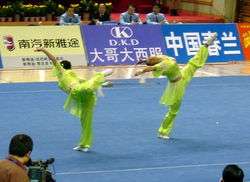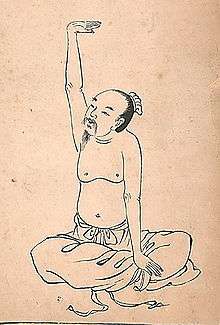Tai chi
Tai chi (Chinese: 太極; pinyin: Tàijí), short for T'ai chi ch'üan or Tàijí quán (太極拳), is an internal Chinese martial art practiced for both its defense training, its health benefits and meditation. The term taiji is a Chinese cosmological concept for the flux of yin and yang, and 'quan' means fist. Etymologically, Taijiquan is a fist system based on the dynamic relationship between polarities (Yin and Yang). Though originally conceived as a martial art, it is also typically practiced for a variety of other personal reasons: competitive wrestling in the format of pushing hands (tui shou), demonstration competitions and achieving greater longevity. As a result, a multitude of training forms exist, both traditional and modern, which correspond to those aims with differing emphasis. Some training forms of tai chi are especially known for being practiced with relatively slow movements.
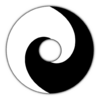 | |
.jpg) Yang Chengfu (c. 1931) in Single Whip posture of Yang-style t'ai chi ch'uan solo form | |
| Also known as | Tàijí; T'ai chi |
|---|---|
| Focus | Chinese Taoist |
| Hardness |
|
| Country of origin | China |
| Creator | Said to be Chen Wangting or Zhang Sanfeng |
| Famous practitioners |
|
| Olympic sport | Demonstration only |
| Tai chi | |||||||||||||||||||||||||||||
|---|---|---|---|---|---|---|---|---|---|---|---|---|---|---|---|---|---|---|---|---|---|---|---|---|---|---|---|---|---|
| Traditional Chinese | 太極拳 | ||||||||||||||||||||||||||||
| Simplified Chinese | 太极拳 | ||||||||||||||||||||||||||||
| Literal meaning | "Supreme Ultimate Boxing" | ||||||||||||||||||||||||||||
| |||||||||||||||||||||||||||||
| Part of a series on |
| Chinese martial arts (Wushu) |
|---|
 |
| Wushu in the world |
|
Historical locations
|
| Wushu athletes/practitioners |
|
Legendary figures
|
|
Historical individuals
|
|
Modern celebrities
|
| Wushu influence |
Today, tai chi has spread worldwide. Most modern styles of tai chi trace their development to at least one of the five traditional schools: Chen, Yang, Wu (Hao), Wu and Sun. All of the former, in turn, trace their historical origins to Chen Village.
Overview
The concept of the taiji ("supreme ultimate"), in contrast with wuji ("without ultimate"), appears in both Taoist and Confucian Chinese philosophy, where it represents the fusion or mother[1] of yin and yang into a single ultimate, represented by the taijitu symbol ![]()
Tai chi training involves five elements, taolu (solo hand and weapons routines/forms), neigong and qigong (breathing, movement and awareness exercises and meditation), tuishou (response drills) and sanshou (self defense techniques). While tai chi is typified by some for its slow movements, many styles (including the three most popular: Yang, Wu and Chen) have secondary forms with faster pace. Some traditional schools teach partner exercises known as tuishou ("pushing hands"), and martial applications of the postures of different forms (taolu).
In China, tai chi is categorized under the Wudang grouping of Chinese martial arts[2]—that is, the arts applied with internal power.[3] Although the term Wudang suggests these arts originated in the Wudang Mountains, it is simply used to distinguish the skills, theories and applications of neijia (internal arts) from those of the Shaolin grouping, or waijia (hard or external) styles.[4]
Since the earliest widespread promotion of the health benefits of tai chi by Yang Shaohou, Yang Chengfu, Wu Chien-ch‘üan and Sun Lutang in the early 20th century,[5] it has developed a worldwide following of people, often with little or no interest in martial training, for its benefit to personal health.[6] Medical studies of t‘ai-chi support its effectiveness as an alternative exercise and a form of martial arts therapy.
It is purported that focusing the mind solely on the movements of the form helps to bring about a state of mental calm and clarity. Besides general health benefits and stress management attributed to tai chi training, aspects of traditional Chinese medicine are taught to advanced students in some traditional schools.[7]
Some other forms of martial arts require students to wear a uniform during practice. In general, tai chi schools do not require a uniform, but both traditional and modern teachers often advocate loose, comfortable clothing and flat-soled shoes.[8][9]
The physical techniques of tai chi are described in the "T‘ai-chi classics", a set of writings by traditional masters, as being characterized by the use of leverage through the joints based on coordination and relaxation, rather than muscular tension, in order to neutralize, yield or initiate attacks. The slow, repetitive work involved in the process of learning how that leverage is generated gently and measurably increases, as well as opens, the internal circulation (breath, body heat, blood, lymph, peristalsis).
The study of tai chi primarily involves three aspects:
- Health: An unhealthy or otherwise uncomfortable person may find it difficult to meditate to a state of calmness or to use tai chi as a martial art. Tai chi's health training, therefore, concentrates on relieving the physical effects of stress on the body and mind. For those focused on tai chi's martial application, good physical fitness is an important step towards effective self-defense.
- Meditation: The focus and calmness cultivated by the meditative aspect of tai chi is seen as necessary in maintaining optimum health (in the sense of relieving stress and maintaining homeostasis) and in application of the form as a soft style martial art.
- Martial art: The ability to use tai chi as a form of self-defense in combat is the test of a student's understanding of the art. Tai chi is the study of appropriate change in response to outside forces, the study of yielding and sticking to an incoming attack rather than attempting to meet it with opposing force.[10] The use of tai chi as a martial art is quite challenging and requires a great deal of training.[11]
Name
Tàijíquán and T‘ai-chi ch‘üan are two different transcriptions of three Chinese characters that are the written Chinese name for the artform:
| Characters | Wade–Giles | Pinyin | Meaning |
|---|---|---|---|
| 太极 | t‘ai chi | tàijí | the source, the beginning |
| 拳 | ch‘üan | quán | fist, boxing |
Despite the one Chinese spelling, 太极拳, there are two different spellings in the English usage, one derived from the Wade–Giles and the other from the Pinyin transcription. Most Westerners often shorten this name to t‘ai chi (often omitting the aspirate sign—thus becoming "tai chi"). This shortened name is the same as that of the t‘ai-chi philosophy, sometimes causing confusion of the two. However, the Pinyin romanization is taiji. The chi in the name of the martial art should not be mistaken for ch‘i, (qi 气 the "life force") especially as ch‘i is involved in the practice of t‘ai-chi ch‘üan. Although the word 极 is traditionally written chi in English, the closest pronunciation, using English sounds, to that of standard Mandarin would be jee, with j pronounced as in jump and ee pronounced as in bee. Other words exist with Mandarin pronunciations in which the ch is pronounced as in chump. Thus, it's important, to avoid confusion, to use the j sound. This potential for confusion suggests preferring the pinyin spelling, taiji. Most Chinese, including many professional practitioners, masters, and martial arts bodies (such as the International Wushu Federation (IWUF)), use the Pinyin version.[12]
Historical origin
From a modern historical perspective, when tracing tai chi's formative influences to Taoist and Buddhist monasteries, there seems little more to go on than legendary tales. Nevertheless, some traditional schools claim that tai chi has a practical connection to and dependence upon the theories of Song dynasty Neo-Confucianism (a conscious synthesis of Taoist, Buddhist, and Confucian traditions, especially the teachings of Mencius).[4] These schools believe that tai chi's theories and practice were formulated by the Taoist monk Zhang Sanfeng in the 12th century, at about the same time that the principles of the Neo-Confucian school were making themselves felt in Chinese intellectual life.[4] However, modern research casts serious doubts on the validity of those claims, pointing out that a 17th-century piece called "Epitaph for Wang Zhengnan" (1669), composed by Huang Zongxi (1610–1695), is the earliest reference indicating any connection between Zhang Sanfeng and martial arts whatsoever, and must not be taken literally but must be understood as a political metaphor instead. Claims of connections between tai chi and Zhang Sanfeng appeared no earlier than the 19th century.[13]
History records that Yang Luchan trained with the Chen family for 18 years before he started to teach the art in Beijing, which strongly suggests that his art was based on, or heavily influenced by, the Chen family art. The Chen family are able to trace the development of their art back to Chen Wangting in the 17th century. Martial arts historian Xu Zhen believed that the tai chi of Chen Village had been influenced by the Taizu changquan style practiced at the nearby Shaolin Monastery, while Tang Hao thought it was derived from a treatise by the Ming dynasty general Qi Jiguang, Jixiao Xinshu ("New Treatise on Military Efficiency"), which discussed several martial arts styles including Taizu changquan.[14][15]
What is now known as tai chi appears to have received this appellation from only around the mid of the 19th century.[13] A scholar in the Imperial Court by the name of Ong Tong He witnessed a demonstration by Yang Luchan at a time before Yang had established his reputation as a teacher. Afterwards Ong wrote: "Hands holding Tai chi shakes the whole world, a chest containing ultimate skill defeats a gathering of heroes." Before this time the art may have had a number of different names, and appears to have been generically described by outsiders as zhan quan (沾拳, "touch boxing"), Mian Quan ("soft boxing") or shisan shi (十三式, "the thirteen techniques").[16]
History and styles
There are five major styles of tai chi, each named after the Chinese family from which it originated:
- Chen style (陳氏) of Chen Wangting (1580–1660)
- Yang style (楊氏) of Yang Luchan (1799–1872)
- Wu Hao style (武氏) of Wu Yuxiang (1812–1880)
- Wu style (吳氏) of Wu Quanyou (1834–1902) and his son Wu Jianquan (1870–1942)
- Sun style (孫氏) of Sun Lutang (1861–1932)
The order of verifiable age is as listed above. The order of popularity (in terms of number of practitioners) is Yang, Wu, Chen, Sun and Wu/Hao.[4] The major family styles share much underlying theory, but differ in their approaches to training.
There are now dozens of new styles, hybrid styles, and offshoots of the main styles, but the five family schools are the groups recognized by the international community as being the orthodox styles. Other important styles are Zhaobao tàijíquán, a close cousin of Chen style, which has been newly recognized by Western practitioners as a distinct style; the Fu style, created by Fu Chen Sung, which evolved from Chen, Sun and Yang styles, and also incorporates movements from Baguazhang (Pa Kua Chang); and the Cheng Man-ch'ing style which is a simplification of the traditional Yang style.
Most existing styles can be traced back to the Chen style, which had been passed down as a family secret for generations. The Chen family chronicles record Chen Wangting, of the family's 9th generation, as the inventor of what is known today as tai chi. Yang Luchan became the first person outside the family to learn tai chi. His success in fighting earned him the nickname Yang Wudi, which means "Unbeatable Yang", and his fame and efforts in teaching greatly contributed to the subsequent spreading of tai chi knowledge. The designation internal or neijia martial arts is also used to broadly distinguish what are known as the external or waijia styles based on the Shaolinquan styles, although that distinction is sometimes disputed by modern schools. In this broad sense, all styles of t'ai chi, as well as related arts such as Baguazhang and Xingyiquan, are, therefore, considered to be "soft" or "internal" martial arts.
Tai chi in the United States of America
Choy Hok Pang, a disciple of Yang Chengfu, was the first known proponent of tai chi to openly teach in the United States of America in 1939. Subsequently, his son and student Choy Kam Man emigrated to San Francisco from Hong Kong in 1949 to teach t‘ai-chi ch‘üan in San Francisco's Chinatown. Choy Kam Man taught until he died in 1994.[17][18]
Sophia Delza, a professional dancer and student of Ma Yueliang, performed the first known public demonstration of tai chi in the United States at the Museum of Modern Art in New York City in 1954. She also wrote the first English language book on t‘ai-chi, "T‘ai-chi ch‘üan: Body and Mind in Harmony", in 1961. She taught regular classes at Carnegie Hall, the Actors Studio, and the United Nations.[19][20]
Another early practitioner of tai chi to openly teach in the United States was Zheng Manqing/Cheng Man-ch'ing, who opened his school Shr Jung t‘ai-chi after he moved to New York from Taiwan in year 1964. Unlike the older generation of practitioners, Zheng was cultured and educated in American ways, and thus he was able to transcribe Yang's dictation into a written manuscript that became the de facto manual for Yang style. Zheng felt Yang's traditional 108-movement long form was unnecessarily long and repetitive, which makes it difficult to learn and make progress. He thus created a shortened 37-movement version and taught that in his schools. Zheng's form became very popular and was the dominant form in the eastern United States until other teachers started to emigrate to the United States in larger numbers in the 90's. He taught until his death in 1975.[21]
Tai chi in the United Kingdom
Norwegian Pytt Geddes was the first European to teach tai chi in Britain, holding classes at The Place in London in the early 1960s. She had first encountered tai chi in Shanghai in 1948, and studied it with Choy Hok Pang and his son Choy Kam Man (who both also taught in the United States) while living in Hong Kong in the late 1950s.[22]
T‘ai-chi ch‘üan lineage tree
Note:
- This lineage tree is not comprehensive, but depicts those considered the "gate-keepers" and most recognised individuals in each generation of the respective styles.
- Although many styles were passed down to respective descendants of the same family, the lineage focused on is that of the martial art and its main styles, not necessarily that of the families.
- Each (coloured) style depicted below has a lineage tree on its respective article page that is focused on that specific style, showing a greater insight into the highly significant individuals in its lineage.
- Names denoted by an asterisk are legendary or semi-legendary figures in the lineage; while their involvement in the lineage is accepted by most of the major schools, it is not independently verifiable from known historical records.
| Key: | |||||||||||||||||||||||||||||||||||||||||||||||||||||||||||||||||||||||||||||||||||||||||
| Solid lines | Direct teacher-student. | (张三丰) Zhang Sanfeng* c. 12th century NEIJIA | |||||||||||||||||||||||||||||||||||||||||||||||||||||||||||||||||||||||||||||||||||||||
| Dashed lines | Individual(s) omitted. | Various Daoists | Legendary figures | ||||||||||||||||||||||||||||||||||||||||||||||||||||||||||||||||||||||||||||||||||||||
| Dotted lines | Partial influence /taught informally /limited time. | (王宗岳) Wang Zongyue* TAIJIQUAN | |||||||||||||||||||||||||||||||||||||||||||||||||||||||||||||||||||||||||||||||||||||||
| Dashed cross | Branch continues. | ||||||||||||||||||||||||||||||||||||||||||||||||||||||||||||||||||||||||||||||||||||||||
| (陈王庭) Chen Wangting 1580–1660 CHEN-STYLE | (蒋法) Jiang Fa Zhaobao-style | ||||||||||||||||||||||||||||||||||||||||||||||||||||||||||||||||||||||||||||||||||||||||
| (陈汝信) Chen Ruxin 2nd gen. Chen | (陈所乐) Chen Suole 2nd gen. Chen | (邢喜怀) Xing Xihuai 2nd gen. Zhaobao | |||||||||||||||||||||||||||||||||||||||||||||||||||||||||||||||||||||||||||||||||||||||
| (陈大鹍) Chen Dakun 3rd gen. Chen | (陈大鹏) Chen Dapeng 3rd gen. Chen | (陈光印) Chen Guangyin 3rd gen. Chen | (陈申如) Chen Shenru 3rd gen. Chen | (陈恂如) Chen Xunru 3rd gen. Chen | (陈正如) Chen Zhengru 3rd gen. Chen | (张楚臣) Zhang Chuchen 3rd gen. Zhaobao | |||||||||||||||||||||||||||||||||||||||||||||||||||||||||||||||||||||||||||||||||||
| (陈善通) Chen Shantong 4th gen. Chen | (陈善志) Chen Shanzhi 4th gen. Chen | (陈继夏) Chen Jixia 4th gen. Chen | (陈节) Chen Jie 4th gen. Chen | (陈敬伯) Chen Jingbo 4th gen. Chen 4th gen. Zhaobao | |||||||||||||||||||||||||||||||||||||||||||||||||||||||||||||||||||||||||||||||||||||
| (陈秉奇) Chen Bingqi 5th gen. Chen | (陈秉壬) Chen Bingren 5th gen. Chen | (陈秉旺) Chen Bingwang 1748–? 5th gen. Chen | (陈公兆) Chen Gongzhao 1715– after 1795 5th gen. Chen | (张宗禹) Zhang Zongyu 5th gen. Zhaobao | |||||||||||||||||||||||||||||||||||||||||||||||||||||||||||||||||||||||||||||||||||||
| (陈长兴) Chen Changxing 1771–1853 6th gen. Chen Chen Old Frame | (陈有本) Chen Youben c. 19th century 6th gen. Chen Chen Small Frame | (张彦) Zhang Yan 6th gen. Zhaobao | |||||||||||||||||||||||||||||||||||||||||||||||||||||||||||||||||||||||||||||||||||||||
| (陈耕耘) Chen Gengyun 7th gen. Chen | (陈仲甡) Chen Zhongshen 1809–1871 7th gen. Chen Chen Small Frame | (杨露禅) Yang Luchan 1799–1872 YANG-STYLE Guang Ping Yang Yangjia Michuan | (陈清萍) Chen Qingping 1795–1868 7th gen. Chen 7th gen. Zhaobao | ||||||||||||||||||||||||||||||||||||||||||||||||||||||||||||||||||||||||||||||||||||||
| (陈延熙) Chen Yanxi 8th gen. Chen | (陈鑫) Chen Xin 1849–1929 8th gen. Chen Chen Small Frame | (王兰亭) Wang Lanting 1840–? 2nd gen. Yang | (杨健侯) Yang Jianhou 1839–1917 2nd gen. Yang 2nd gen. Yangjia Michuan | (杨班侯) Yang Banhou 1837–1892 2nd gen. Yang 2nd gen. Guang Ping Yang Yang Small Frame | (武禹襄) Wu Yuxiang 1812–1880 WU (HAO)-STYLE | (他招远) He Zhaoyuan 1810–1890 8th gen. Zhaobao Zhaobao He-style | |||||||||||||||||||||||||||||||||||||||||||||||||||||||||||||||||||||||||||||||||||
| (陈发科) Chen Fake 1887–1957 9th gen. Chen Chen New Frame | (陈克忠) Chen Kezhong 1908–1966 9th gen. Chen Chen Small Frame | (李瑞东) Li Ruidong 1851–1917 Li-style | (杨澄甫) Yang Chengfu 1883–1936 3rd gen. Yang Yang Big Frame | (杨少侯) Yang Shaohou 1862–1930 3rd gen. Yang Yang Small Frame | (吴全佑) Wu Quanyou 1834–1902 1st gen. Wu | (王矯宇) Wang Jiaoyu 1836–1939 3rd gen. Guang Ping Yang | (李亦畬) Li Yiyu 1832–1892 2nd gen. Wu (Hao) | (和庆喜) He Qingxi 1857–1936 9th gen. Zhaobao | |||||||||||||||||||||||||||||||||||||||||||||||||||||||||||||||||||||||||||||||||
| (陈照丕) Chen Zhaopi 1893–1972 10th gen. Chen focused on Chen Old Frame | (陈照奎) Chen Zhaokui 1928–1981 10th gen. Chen focused on Chen New Frame | (陈伯祥) Chen Boxiang b. 1944 10th gen. Chen Chen Small Frame | (張欽霖) Zhang Qinlin 1888–1967 3rd gen. Yangjia Michuan | (杨振铎) Yang Zhenduo b. 1926 4th gen. Yang | (傅仲文) Fu Zhongwen 1903–1994 4th gen. Yang Beijing (24) form | (郑曼青) Zheng Manqing 1902–1975 4th gen. Yang Short (37) Form | (吴鉴泉) Wu Jianquan 1870–1942 2nd gen. Wu WU-STYLE 108 Form | Kuo Lien Ying 1895–1984 4th gen. Guang Ping Yang | (郝為真) Hao Weizhen 1849–1920 3rd gen. Wu (Hao) | (郑悟清) Zheng Wuqing 1895–1984 10th gen. Zhaobao | |||||||||||||||||||||||||||||||||||||||||||||||||||||||||||||||||||||||||||||||
| (吴公儀) Wu Gongyi 1900–1970 3rd gen. Wu | (孙禄堂) Sun Lutang 1861–1932 SUN-STYLE | (郝月如) Hao Yueru 1877–1935 4th gen. Wu (Hao) | |||||||||||||||||||||||||||||||||||||||||||||||||||||||||||||||||||||||||||||||||||||||
| (王延年) Wang Yannian 1914–2008 5th gen. Yang 4th gen. Yangjia Michuan | (鄭天熊) Zheng Tianxiong 1930–2005 Wudang-style | (吴雁霞) Wu Yanxia 1930–2001 4th gen. Wu | (孙剑云) Sun Jianyun 1913–2003 2nd gen. Sun | (郝少如) Hao Shaoru 1908–1983 5th gen. Wu (Hao) | |||||||||||||||||||||||||||||||||||||||||||||||||||||||||||||||||||||||||||||||||||||
| (陈小旺) Chen Xiaowang b. 1945 11th gen. Chen | (陈小星) Chen Xiaoxing b. 1952 11th gen. Chen | (陆志众) Lu Zhizhong b. 1965 11th gen. Chen Chen Small Frame | (杨军) Yang Jun b. 1968 5th gen. Yang | (吴光宇) Wu Guangyu b. 1946 5th gen. Wu | (孙永田) Sun Yongtian b. ? 3rd gen. Sun | (刘积顺) Liu Jishun b. 1930 6th gen. Wu (Hao) | |||||||||||||||||||||||||||||||||||||||||||||||||||||||||||||||||||||||||||||||||||
| CHEN-STYLE | Chen Small Frame | YANG-STYLE | WU-STYLE | SUN-STYLE | WU (HAO)-STYLE | ||||||||||||||||||||||||||||||||||||||||||||||||||||||||||||||||||||||||||||||||||||
Modern forms
The Cheng Man-ch‘ing (Zheng Manqing) and Chinese Sports Commission short forms are derived from Yang family forms, but neither is recognized as Yang family tai chi by standard-bearing Yang family teachers. The Chen, Yang, and Wu families are now promoting their own shortened demonstration forms for competitive purposes.
| (杨澄甫) Yang Chengfu 1883–1936 3rd gen. Yang Yang Big Frame | |||||||||||||
| (郑曼青) Zheng Manqing 1902–1975 4th gen. Yang Short (37) Form | Chinese Sports Commission 1956 Beijing (24) Form | ||||||||||||
| 1989 42 Competition Form (Wushu competition form combined from Chen, Yang, Wu & Sun styles) | |||||||||||||
Tai chi today
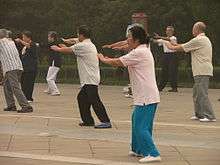
In the last twenty years or so, tai chi classes that purely emphasise health have become popular in hospitals, clinics, as well as community and senior centres. This has occurred as the baby boomers generation has aged and the art's reputation as a low-stress training method for seniors has become better known.[23]
As a result of this popularity, there has been some divergence between those that say they practice tai chi primarily for self-defence, those that practice it for its aesthetic appeal (see wushu below), and those that are more interested in its benefits to physical and mental health. The wushu aspect is primarily for show; the forms taught for those purposes are designed to earn points in competition and are mostly unconcerned with either health maintenance or martial ability. More traditional stylists believe the two aspects of health and martial arts are equally necessary: the yin and yang of tai chi. The tai chi "family" schools, therefore, still present their teachings in a martial art context, whatever the intention of their students in studying the art.[24]
Tai chi as sport
In order to standardize t‘ai-chi ch‘üan for wushu tournament judging, and because many tai chi teachers have either moved out of China or had been forced to stop teaching after the Chinese Civil War in 1949, the government sponsored the Chinese Sports Committee, who brought together four of their wushu teachers to truncate the Yang family hand form to 24 postures in 1956. They wanted to retain the look of tai chi, but create a routine that would be less difficult to teach and much less difficult to learn than longer (in general, 88 to 108 posture), classical, solo hand forms. In 1976, they developed a slightly longer form also for the purposes of demonstration that still would not involve the complete memory, balance, and coordination requirements of the traditional forms. This became the "Combined 48 Forms" that were created by three wushu coaches, headed by Men Hui Feng. The combined forms were created based on simplifying and combining some features of the classical forms from four of the original styles: Chen, Yang, Wu, and Sun. As tai chi again became popular on the mainland, more competitive forms were developed to be completed within a six-minute time limit. In the late 1980s, the Chinese Sports Committee standardized many different competition forms. They developed sets to represent the four major styles as well as combined forms. These five sets of forms were created by different teams, and later approved by a committee of wushu coaches in China. All sets of forms thus created were named after their style: the "Chen-style national competition form" is the "56 Forms". The combined forms are "The 42-Form" or simply the "Competition Form".
Another modern form is the "97 movements combined t‘ai-chi ch‘üan form", created in the 1950s; it contains characteristics of the Yang, Wu, Sun, Chen, and Fu styles blended into a combined form. The wushu coach Bow Sim Mark is a notable exponent of the "67 combined form".
These modern versions of tai chi have since become an integral part of international wushu tournament competition, and have been featured in popular movies, starring or choreographed by well-known wushu competitors, such as Jet Li and Donnie Yen.
In the 11th Asian Games of 1990, wushu was included as an item for competition for the first time with the 42-Form being chosen to represent t‘ai-chi ch‘üan. The International Wushu Federation (IWUF) applied for wushu to be part of the Olympic games, but will not count medals.[25]
Practitioners also test their practical martial skills against students from other schools and martial arts styles in tuishou ("pushing hands") and sanshou competition.
Philosophy
The philosophy of tai chi is that, if one uses hardness to resist violent force, then both sides are certain to be injured at least to some degree. Such injury, according to tai chi, is a natural consequence of meeting brute force with brute force. Instead, students are taught not to directly fight or resist an incoming force, but to meet it in softness and follow its motion while remaining in physical contact until the incoming force of attack exhausts itself or can be safely redirected, meeting yang with yin. When done correctly, this yin/yang or yang/yin balance in combat, or in a broader philosophical sense, is a primary goal of tai chi training. Lao Tzŭ provided the archetype for this in the Tao Te Ching when he wrote, "The soft and the pliable will defeat the hard and strong."
Traditional schools also emphasize that one is expected to show wude ("martial virtue/heroism"), to protect the defenseless, and show mercy to one's opponents.[5]
Training and techniques
The core training involves two primary features: the first being taolu (solo "forms"), a sequence of movements which emphasize a straight spine, abdominal breathing and a natural range of motion; the second being different styles of tuishou ("pushing hands") for training movement principles of the form with a partner and in a more practical manner.
Solo (taolu, neigong and qigong)
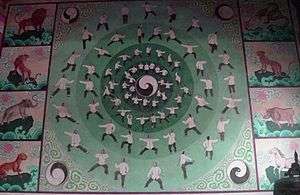
The taolu (solo "forms") should take the students through a complete, natural range of motion over their centre of gravity. Accurate, repeated practice of the solo routine is said to retrain posture, encourage circulation throughout the students' bodies, maintain flexibility through their joints, and further familiarize students with the martial application sequences implied by the various forms. The major traditional styles of tai chi have forms that differ somewhat in terms of aesthetics, but there are also many obvious similarities that point to their common origin. The solo forms (empty-hand and weapon) are catalogues of movements that are practised individually in pushing hands and martial application scenarios to prepare students for self-defence training. In most traditional schools, different variations of the solo forms can be practised: fast / slow, small-circle / large-circle, square / round (which are different expressions of leverage through the joints), low-sitting / high-sitting (the degree to which weight-bearing knees are kept bent throughout the form), for example.
Breathing exercises; neigong (internal skill) or, more commonly, qigong (life energy cultivation) are practiced to develop qi (life energy) in coordination with physical movement and zhan zhuang (standing like a post) or combinations of the two. These were formerly taught only to disciples as a separate, complementary training system. In the last 60 years they have become better known to the general public.
Qigong versus tai chi
Qigong involves coordinated movement, breath, and awareness used for health, meditation, and martial arts training. While many scholars and practitioners consider tai chi to be a type of qigong,[26][27] the two are commonly distinguished as separate but closely related practices, with qigong playing an important role in training for tai chi, and with many tai chi movements performed as part of qigong practice. The focus of qigong is typically more on health or meditation than martial applications. Internally the main difference is the flow of qi. In qigong, the flow of qi is held at a gate point for a moment to aid the opening and cleansing of the channels. In tai chi, the flow of qi is continuous, thus allowing the development of power for the use by the practitioner.
Partnered (tuishou and sanshou)

Tai chi's martial aspect relies on sensitivity to the opponent's movements and centre of gravity dictating appropriate responses. Effectively affecting the opponent's centre of gravity immediately upon contact is trained as the primary goal of the martial t‘ai-chi ch‘üan student.[7] The sensitivity needed to capture the centre is acquired over thousands of hours of first yin (slow, repetitive, meditative, low-impact) and then later adding yang (realistic, active, fast, high-impact) martial training through taolu (forms), tuishou (pushing hands), and sanshou (sparring). Tai chi trains in three basic ranges: close, medium and long, and then everything in between. Pushes and open-hand strikes are more common than punches, and kicks are usually to the legs and lower torso, never higher than the hip, depending on style. The fingers, fists, palms, sides of the hands, wrists, forearms, elbows, shoulders, back, hips, knees, and feet are commonly used to strike, with strikes to the eyes, throat, heart, groin, and other acupressure points trained by advanced students. Chin na, which are joint traps, locks, and breaks are also used. Most tai chi teachers expect their students to thoroughly learn defensive or neutralizing skills first, and a student will have to demonstrate proficiency with them before offensive skills will be extensively trained.
In addition to the physical form, martial tai chi schools also focus on how the energy of a strike affects the other person. A palm strike that looks to have the same movement may be performed in such a way that it has a completely different effect on the target's body. A palm strike that could simply push the opponent backward, could instead be focused in such a way as to lift the opponent vertically off the ground, breaking his/her centre of gravity; or that it could terminate the force of the strike within the other person's body with the intent of causing internal damage.
Most aspects of a trainee's tai chi development are meant to be covered within the partnered practice of tuishou, and so, sanshou (sparring) is not as commonly used as a method of training, but more advanced students sometimes do practice by sanshou. Sanshou is more common to tournaments such as wushu tournaments.
Weapons
Variations of tai chi (taiji) involving weapons also exist. The weapons training and fencing applications employ:
- the jian, a straight double-edged sword, practiced as taijijian;
- the dao, a heavier curved saber, sometimes called a broadsword;
- the tieshan, a folding fan, also called shan and practiced as taijishan;
- the gun, a 2 m long wooden staff and practiced as taijigun;
- the qiang, a 2 m long spear or a 4 m long lance.
More exotic weapons still used by some traditional styles include:
- the large dadao and podao sabres;
- the ji, or halberd;
- the cane;
- the sheng biao, or rope dart;
- the sanjiegun, or three sectional staff;
- the feng huo lun, or wind and fire wheels;
- the lasso;
- the whip, chain whip and steel whip.
Health

Tai chi has soft movements, slower speeds, and not difficult to learn. The posture of high or low and the amount of exercise can be different according to individual physical fitness. It can meet the needs of different ages, physical and patent. Whether it is theoretical research or practice, it improves technical skills and maintains health. People who practice tai chi are mainly doing so for physical exercise.
As an exercise, tai chi is suitable for people of all ages, especially those under 30 years of age. It essentially stimulates blood circulation, relaxation, and joints while promoting mental relaxation. A large number of clinical studies on specific diseases and health conditions have demonstrated the safety and health benefits of tai chi in physical and mental exercise.[28]
Tai chi has been reported as being useful in treating a number of human ailments, and is supported by a number of associations, including the National Parkinson Foundation and Diabetes Australia. However, medical evidence of effectiveness was lacking and in recent years research has been undertaken to address this.[29][30] A 2017 systematic review found that it decreased the risk of falls in older people.[31]
A 2011 comprehensive overview of systematic reviews of tai chi recommended tai chi to older people for its various physical and psychological benefits. There was no conclusive evidence of benefit for any of the other conditions researched, including Parkinson's disease, diabetes, cancer and arthritis.[29]
A 2015 systematic review found tai chi could be performed by those with chronic medical conditions such as chronic obstructive pulmonary disease, heart failure, and osteoarthritis without worsening shortness of breath and pain, and found favorable effects on functional exercise capacity in people with these conditions.[32]
In 2015 the Australian Government's Department of Health published the results of a review of alternative therapies that sought to determine if any were suitable for being covered by health insurance; t‘ai-chi was one of 17 therapies evaluated and the conclusion was that there is very-low-quality evidence to suggest that tai chi may have some beneficial health effects when compared to control in a limited number of populations for a limited number of outcomes.[30]
Seated tai chi
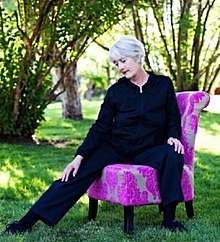
Traditional tai chi was originally developed for self-defense, but tai chi has evolved into a graceful form of seated exercise that's now used for stress reduction and a variety of other health conditions. Often described as meditation in motion, seated tai chi promotes serenity through gentle, flowing movements. Worthy of note is the growing popularity of seated tai chi exercises touted by the medical community and researchers. Seated tai chi is based primarily on the Yang short form, and is being used by the general public, medical practitioners, and tai chi instructors in a growing elderly population. It would have been possible to simply take the well-known yang short form and redesign it for seated positions. There is, however, the matter of the integrity of the form itself. Within any tai chi form, there lies a certain inherent logic and purpose to each of the movements. The synchronization of the upper body with the steps and the breathing exists in a very carefully crafted order developed over hundreds of years, and the transition to seated positions is an important factor in the movements themselves. Research has shown that seated tai chi techniques can make big improvements to a person's physical and mental well being. Marked improvements in balance, blood pressure levels, flexibility and muscle strength, peak oxygen intake, and body fat percentages can be achieved.[33]
Legends and anecdotes
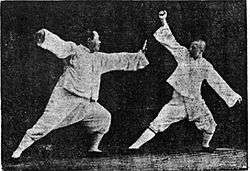
- During the Qing dynasty, a man named Wang Yuanwai living in Beipinggao village (about 10 kilometres (6.2 mi) east of Chenjiagou), was threatened with death by a gang of highwaymen with bladed weapons, unless he surrendered his valuables. He sent for assistance from Chen Suole (see the lineage tree above), who was away according to his sons Chen Shenru and Chen Xunru – despite their being only around fifteen and sixteen years old, the boys volunteered their own help instead. They convinced the messenger to tell Wang Yuanwai to give the bandits liquor, discussed a plan and that night, traveled to the Wang residence in Beipinggao, where they jumped over the fence of the rear garden and there found Wang Yuanwai. He told them that the highwaymen, numbering around twenty, were drunken in his guest hall. While peeping in, Shenru pushed Xunru into the hall and extinguished several candles by throwing a bunch of peas at them. Xunru leapt onto beam and taunted, the panicked bandits who had seemingly started fighting each other, saying, "So you still will not hand over your weapons and surrender? Gods number one and two are here." Some tried to escape the frenzy, but were attacked by Shenru, who was still at the door.[34]
- In the 1940s, a man known as "Big Spear Liu" came to Shanghai's "big world," the city's major performance and entertainment centre. Liu asked the doorkeeper, "Are there any good hands around here?", looking for a skilled opponent to challenge. The doorkeeper told "Big Spear Liu" of Tian Zhaolin (student of Yang Jianhou). With that Liu set off to find him. He found Tian Zhaolin and immediately demanded to spar by each striking the other three times, to which Tian Zhaolin responded that it may not be necessary. He said, "Just let me touch you. If you can tolerate my touch, you win." Liu, sensing a fool and an effortless victory, immediately agreed. The two men approached and Tian Zhaolin reached out his hand to touch Liu's chest. Within a few moments, Liu's facial muscles started to contort. Soon he grimaced and his face showed signs of intense pain. Spear Liu pulled away and, after recovering, commented, "I have travelled throughout five provinces and various cities but until today I have never seen such a profound skill." Energy, including that of tai chi, may be thought of as transmission by wave. Earlier generation adepts in tai chi had an expression—"hitting the cow on this side of the Mountain." This phrase referred to hitting an opponent's front side with the pain and effect being felt on the back side. In years past, people who sparred with Yang Shaohou often described him as also having an energy like electricity. That is, it caused very painful sensations in the muscle and even on the skin surface. Tian Zhaolin, coming from that background, also knew this method.[35]
- In 1945, Hu Yuen Chou, a student of Yang Chengfu, defeated a Russian boxer by TKO in a full-contact match in Fut San, China.
- At the age of 60, Huang Sheng Shyan demonstrated his abilities in tai chi by defeating Liao Kuang-Cheng, the Asian champion wrestler, 26 throws to 0 in a fund raising event in Kuching, Malaysia.[36]
Attire and ranking
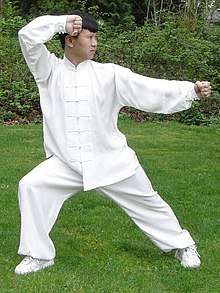
In practice traditionally there is no specific uniform required in the practice of tai chi. Modern day practitioners usually wear comfortable, loose T-shirts and trousers made from breathable natural fabrics, that allow for free movement during practice. Despite this, t‘ai-chi ch‘üan has become synonymous with "t‘ai-chi uniforms" or "kung fu uniforms" that usually consist of loose-fitting traditional Chinese styled trousers and a long or short-sleeved shirt, with a Mandarin collar and buttoned with Chinese frog buttons. The long-sleeved variants are referred to as Northern-style uniforms, whilst the short-sleeved, Southern-style uniforms. The colour of this clothing is usually, all white, all black, black and white, or any other colour, mostly being either all a single solid colour or a combination of 2 colours: one colour being the actual clothing and the binding being a contrasting colour. They are normally made from natural fabrics such as cotton or silk. These uniforms are not a requirement, but rather are usually worn by masters & professional practitioners during demonstrations, tournaments and other public exhibitions.
There is no standardized tai chi ranking system, except the Chinese Wushu Duan wei exam system run by the Chinese wushu association in Beijing. However, most schools do not use belt rankings. Some schools may present students with belts depicting rank, similar to dans in Japanese martial arts. A simple uniform element of respect and allegiance to one's teacher and their methods and community, belts also mark hierarchy, skill, and accomplishment of practice in one school's style and system. During wushu tournaments, masters and grandmasters often wear "kung fu uniforms" which tend to have no belts. Wearing a belt signifying rank in such a situation would be unusual.
Tai Chi as a generic brand

From roughly the mid-1990s onward, tai chi has gained a popularity in some countries to the point of it becoming nearly as known as a health-oriented practice as Yoga. In fact, in modern times it is even more known for such benefits and methods of practice than it is known for its original purpose.
A new phenomenon (since the 2000s) is of various martial arts styles claiming a historical relationship or otherwise with tai chi, because of its popularity. A branch of Lama Pai known as "Tibetan White Crane" had popularized a slow-movement form by naming it "Needle in Cotton" (a common term describing tai chi mechanics), and referring to its practice as "Taiji". However, there is no relationship between these arts, historic or otherwise. A similar phenomenon occurs with the usage of the art's name as a universal brand for promoting various fitness programs, books and videos. There is, for instance, a book that describes how to use the training principles of Taiji to run better.[37] Regardless of the questions of whether such claims are viable, these are all new trends, which historically were not endorsed or promoted by teachers of the art.
In popular culture
- Waterbending in the Nickelodeon shows Avatar: The Last Airbender (2005–2008) and The Legend of Korra (2012–2014) is modeled on Taijiquan.[38]
- In the Dead or Alive series, the character Leifang is a taijiquan prodigy.
- In the TV show Marvel's Agents of S.H.I.E.L.D. the character of Agent Melinda May uses Tai Chi and later teaches it to Agent Skye/Daisy Johnson, the superhero known as Quake.
- Belly of the Beast, a 2003 action movie starring Steven Seagal.
- Out for a kill, an action film starring Steven Seagal.
- Drunken Tai Chi is a kung fu comedy movie starring Donnie Yen.
- In Thomas and Friends, Yong Bao teaches Thomas Tai Chi so that he could stop Lei the goods van safely in the episode Runaway Truck.
- In Joker (2019 film), Joaquin Phoenix performed an unscripted tai chi dance in his portrayal of the titular character after his first murders.[39]
- In an early scene of the movie Easy Rider, Jack, a resident of the commune, (portrayed by actor Robert Walker Jr.) can be observed doing tai chi in the background.[40]
See also
References
- Cheng Man-ch'ing (1993). Cheng-Tzu's Thirteen Treatises on T'ai Chi Ch'uan. North Atlantic Books. p. 21. ISBN 978-0-938190-45-5.
- Sun Lu Tang (2000). Xing Yi Quan Xue. Unique Publications. p. 3. ISBN 0-86568-185-6.
- Ranne, Nabil. "Internal power in Taijiquan". CTND. Retrieved 2011-01-01.
- Wile, Douglas (2007). "Taijiquan and Taoism from Religion to Martial Art and Martial Art to Religion". Journal of Asian Martial Arts. Via Media Publishing. 16 (4). ISSN 1057-8358.
- Wile, Douglas (1995). Lost T'ai-chi Classics from the Late Ch'ing Dynasty (Chinese Philosophy and Culture). State University of New York Press. ISBN 978-0-7914-2654-8.
- Morris, Kelly (1999). "T'ai Chi gently reduces blood pressure in elderly". The Lancet. 353 (9156): 904. doi:10.1016/S0140-6736(05)75012-1.
- Wu, Kung-tsao (2006). Wu Family T'ai Chi Ch'uan (吳家太極拳). Chien-ch'uan T'ai-chi Ch'uan Association. ISBN 0-9780499-0-X.
- Lam, Dr. Paul. "What should I wear to practice Tai Chi?". Tai Chi for Health Institute. Retrieved 2014-12-29.
- Fu, Zhongwen (2006-06-09). Mastering Yang Style Taijiquan. Louis Swaim. Berkeley, California: Blue Snake Books. ISBN 1-58394-152-5.
- Wong Kiew Kit (November 1996). The Complete Book of Tai Chi Chuan: A Comprehensive Guide to the Principles. Element Books Ltd. ISBN 978-1-85230-792-9.
- "Tai Chi Push Hands". Northwest Fighting Arts. Archived from the original on July 6, 2017.
- "International Wushu Federation". iwuf.org. Archived from the original on 2006-02-09.
- Henning, Stanley (1994). "Ignorance, Legend and Taijiquan". Journal of the Chen Style Taijiquan Research Association of Hawaii. 2 (3). Archived from the original on 2010-01-01. Retrieved 2009-11-23.
- "presents... TAIJIQUAN – Origins and Development of Taijiquan". Chinafrominside.com. Retrieved 2016-08-20.
- "presents... TAIJIQUAN – Brief Analysis of Chen Family Boxing Manuals". Chinafrominside.com. Retrieved 2016-08-20.
- "Thirteen Postures of Taijiquan". egreenway.com. Retrieved 2019-09-16.
- Choy, Kam Man (1985-05-05). Tai Chi Chuan. San Francisco, California: Memorial Edition 1994.
- Logan, Logan (1970). Ting: The Caldron, Chinese Art and Identity in San Francisco. San Francisco, California: Glide Urban Center.
- Dunning, Jennifer (July 7, 1996), Sophia Delza Glassgold, 92, Dancer and Teacher, New York Times
- Inventory of the Sophia Delza Papers, 1908–1996 (PDF), Jerome Robbins Dance Division, New York Public Library for the Performing Arts, February 2006
- Wolfe Lowenthal (1991). There Are No Secrets: Professor Cheng Man Ch'ing and His Tai Chi Chuan. North Atlantic Books. ISBN 978-1-55643-112-8.
- "Pytt Geddes (obituary)". The Telegraph. 21 March 2006. Archived from the original on 4 December 2007. Retrieved 16 January 2020.
- Yip, Y. L. (Autumn 2002). "Pivot – Qi". The Journal of Traditional Eastern Health and Fitness. Insight Graphics Publishers. 12 (3). ISSN 1056-4004.
- Woolidge, Doug (June 1997). "T'AI CHI". The International Magazine of T'ai Chi Ch'uan. Wayfarer Publications. 21 (3). ISSN 0730-1049.
- "Wushu likely to be a "specially-set" sport at Olympics". Chinese Olympic Committee. October 17, 2006. Retrieved 2007-04-13.
- Yang, Jwing-Ming (1998). The Essence of Taiji Qigong, Second Edition : The Internal Foundation of Taijiquan (Martial Arts-Qigong). YMAA Publication Center. ISBN 978-1-886969-63-6.
- YeYoung, Bing. "Introduction to Taichi and Qigong". YeYoung Culture Studies: Sacramento, CA <http://sactaichi.com>. Archived from the original on 2014-02-01. Retrieved 2012-01-16.
- Yang, Guo-Yan; Wang, Li-Qiong; Ren, Jun; Zhang, Yan; Li, Meng-Ling; Zhu, Yu-Ting; Luo, Jing; Cheng, Yan-Jun; Li, Wen-Yuan; Wayne, Peter M.; Liu, Jian-Ping (2015-03-16). "Evidence Base of Clinical Studies on Tai Chi: A Bibliometric Analysis". PLOS ONE. 10 (3): e0120655. doi:10.1371/journal.pone.0120655. ISSN 1932-6203. PMC 4361587. PMID 25775125.
- Lee, M. S.; Ernst, E. (2011). "Systematic reviews of t'ai chi: An overview". British Journal of Sports Medicine. 46 (10): 713–8. doi:10.1136/bjsm.2010.080622. PMID 21586406.
- Baggoley C (2015). "Review of the Australian Government Rebate on Natural Therapies for Private Health Insurance" (PDF). Australian Government – Department of Health. Archived from the original (PDF) on 22 December 2015. Retrieved 12 December 2015. Lay summary – Gavura, S. Australian review finds no benefit to 17 natural therapies. Science-Based Medicine. (19 November 2015).
- Lomas-Vega, R; Obrero-Gaitán, E; Molina-Ortega, FJ; Del-Pino-Casado, R (September 2017). "Tai Chi for Risk of Falls. A Meta-analysis". Journal of the American Geriatrics Society. 65 (9): 2037–2043. doi:10.1111/jgs.15008. PMID 28736853.
- Chen, Yi-Wen; Hunt, Michael A.; Campbell, Kristin L.; Peill, Kortni; Reid, W. Darlene (2015-09-17). "The effect of Tai Chi on four chronic conditions – cancer, osteoarthritis, heart failure and chronic obstructive pulmonary disease: a systematic review and meta-analyses". British Journal of Sports Medicine: bjsports-2014-094388. doi:10.1136/bjsports-2014-094388. ISSN 1473-0480. PMID 26383108.
- Quarta, Cynthia W. (2001). Tai Chi in a Chair (first ed.). Fair Winds Press. ISBN 1-931412-60-X.
- The Chen family chronicles
- Clark, Leroy; Sun, Key. "Tian Zhaolin: A Legacy of Yang Taiji". Art-of-Energetics.com. Archived from the original on 2013-02-07. Retrieved 2012-09-01.
- "THE TAIJI JOURNEY OF HUANG SHENG-SHYAN". Archived from the original on 2008-06-12. Retrieved 2008-12-03.
- "Chi Running". Chi Running. Retrieved 2016-08-20.
- "Martial Arts :: AvatarSpirit.net". AvatarSpirit.net.
- Liam Curtis (2019). "Joker: Un-scripted Tai chi dance makes Joaquin Phoenix's performance spine-chillingly perfect". hitc.com. Archived from the original on 11 October 2019. Retrieved 11 October 2019.
- "Tai Chi In The Movie Easy Rider". Slanted Flying. Retrieved 17 October 2019.
Further reading
Books
- Gaffney, David; Sim, Davidine Siaw-Voon (2014). The Essence of Taijiquan. CreateSpace Independent Publishing Platform. ISBN 978-1-5006-0923-8.
- Bluestein, Jonathan (2014). Research of Martial Arts. CreateSpace Independent Publishing Platform. ISBN 978-1-4991-2251-0.
- Yang, Yang; Grubisich, Scott A. (2008). Taijiquan: The Art of Nurturing, The Science of Power (2nd ed.). Zhenwu Publication. ISBN 978-0-9740990-1-9.
- Frantzis, Bruce (2007). The Power of Internal Martial Arts and Chi: Combat and Energy Secrets of Ba Gua, Tai Chi and Hsing-I. Blue Snake Books. ISBN 978-1-58394-190-4.
- Davis, Barbara (2004). Taijiquan Classics: An Annotated Translation. North Atlantic Books. ISBN 978-1-55643-431-0.
- Eberhard, Wolfram (1986). A Dictionary of Chinese Symbols: Hidden Symbols in Chinese Life and Thought. Routledge & Kegan Paul, London. ISBN 0-415-00228-1.
- Choy, Kam Man (1985-05-05). Tai Chi Chuan. San Francisco, California: Memorial Edition 1994.
- Wile, Douglas (1983). Tai Chi Touchstones: Yang Family Secret Transmissions. Sweet Ch'i Press. ISBN 978-0-912059-01-3.
- Bond, Joey (1999-06-01). See Man Jump See God Fall: Tai Chi Vs. Technology. International Promotions Promotion Pub. ISBN 978-1-57901-001-0.

